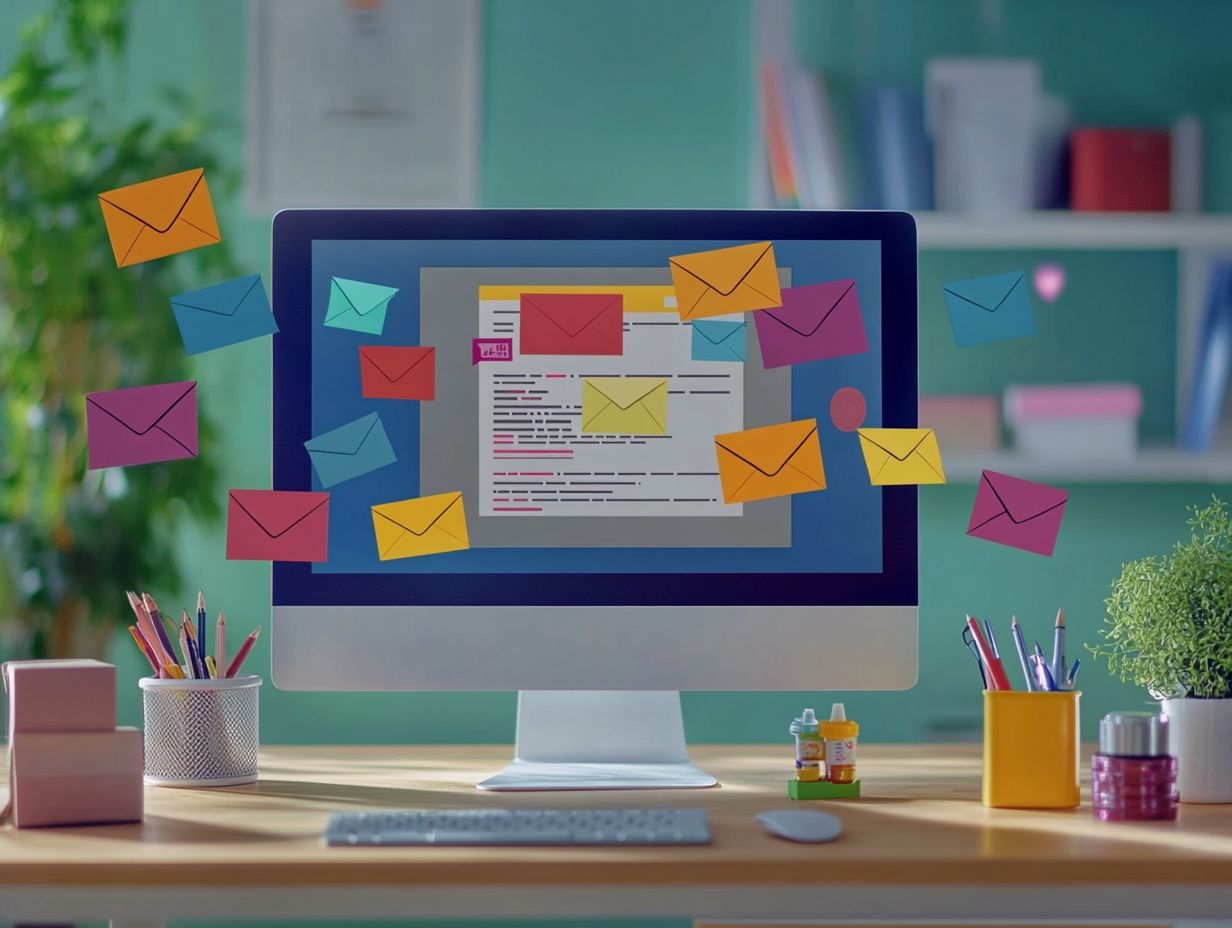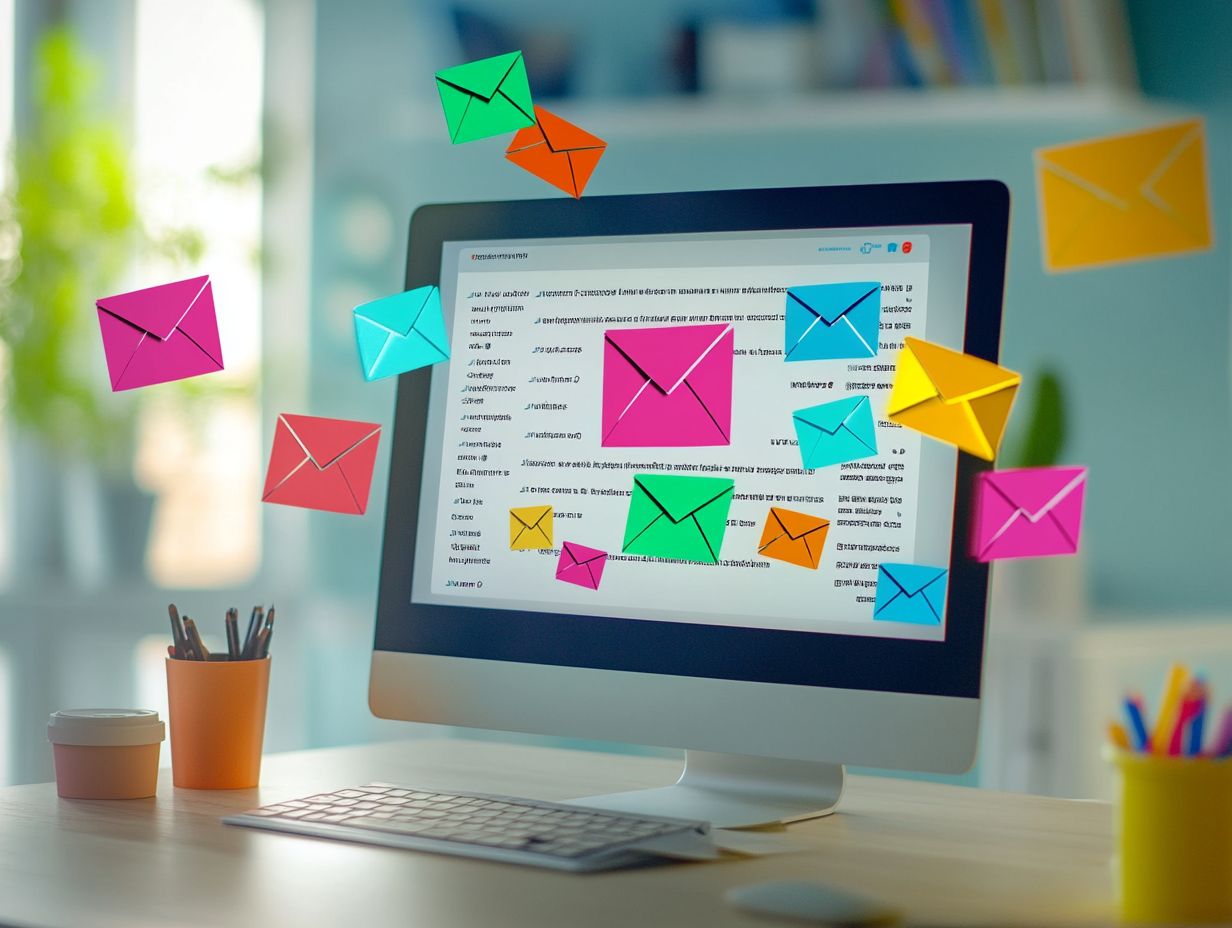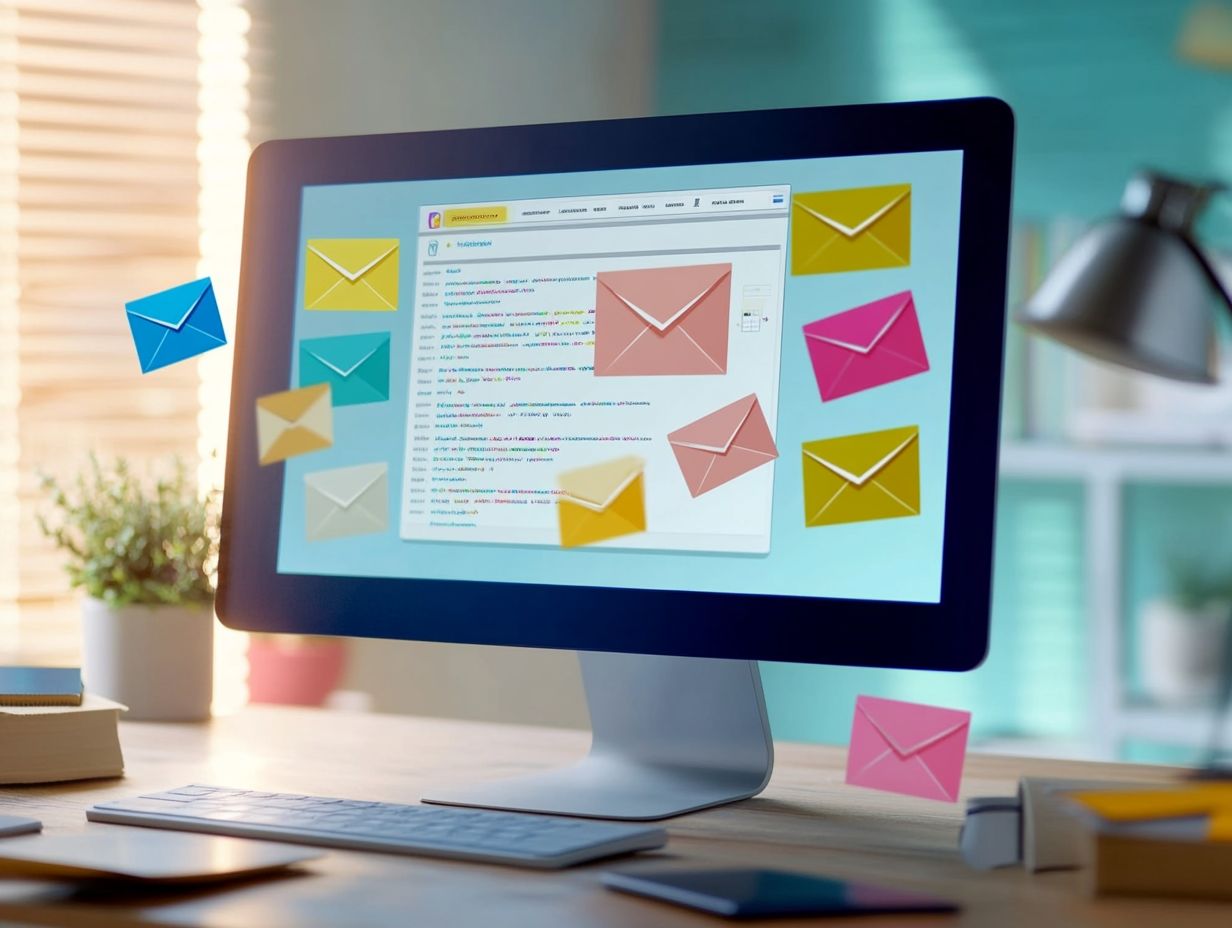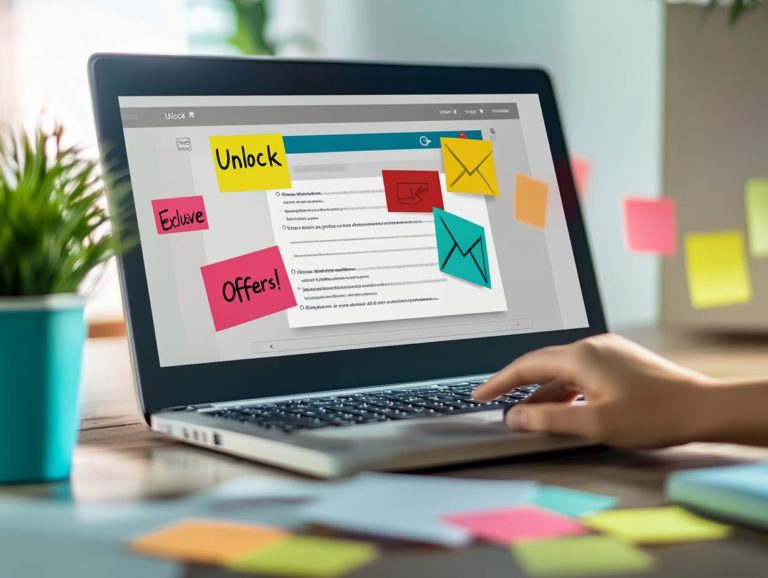Best Email Marketing Practices for E-commerce
Let's Set Up Your Lead Generation Strategy
Fill out the form below, and our team will get in touch with you to create a tailored solution for your business.
In the fast-paced realm of e-commerce, email marketing stands as a formidable tool for nurturing customer relationships and driving sales.
This article delves into the essential components of effective email marketing, guiding you through the processes of building and segmenting your email list. You ll learn how to craft compelling content that truly converts.
You ll uncover various campaign types and explore best practices for design. Additionally, we will outline crucial regulations to ensure your marketing efforts comply with customer retention strategies.
Jump in and unlock the full potential of your e-commerce email strategy right now!
Contents
- Key Takeaways:
- Building an Email List
- Let's Set Up Your Lead Generation Strategy
- Email Marketing Campaigns for E-commerce
- Creating Compelling Email Content
- Let's Set Up Your Lead Generation Strategy
- Segmenting Your Email List
- Measuring Success and Improving Results
- Let's Set Up Your Lead Generation Strategy
- Best Practices for Email Design and Layout
- Complying with Email Marketing Regulations
- Frequently Asked Questions
- Let's Set Up Your Lead Generation Strategy
- How can I segment my email list for e-commerce marketing?
- Why is personalization important in e-commerce email marketing?
- What type of information should I include in my e-commerce email marketing?
- How do I ensure my e-commerce emails are optimized for mobile?
- How can I track the success of my e-commerce email marketing campaigns?
Key Takeaways:

- Build a quality email list using effective strategies to reach a targeted audience for e-commerce success.
- Utilize various types of email campaigns, such as promotional, transactional emails, and re-engagement to drive engagement and sales for your e-commerce business.
- Craft compelling and targeted email content by segmenting your email list and using persuasive writing techniques to improve engagement and conversions.
Why Email Marketing is Important for E-commerce
Email marketing is a cornerstone of success in the e-commerce landscape. It allows you to forge direct relationships with your customers through personalized messages and targeted email campaigns.
As e-commerce flourishes, the significance of email marketing in amplifying customer engagement becomes ever more apparent.
Take cues from brands like YETI and Sephora, which exemplify the power of effective email marketing. YETI’s curation emails showcase seasonal products designed specifically for outdoor enthusiasts. Meanwhile, Sephora’s upsell emails deliver tailored product recommendations based on past purchases.
These focused strategies not only drive sales but also build a stronger bond with your customers.
Ask for feedback! Feedback emails invite your customers to share their experiences, paving the way for enhancements in product offerings and customer service. By leveraging these techniques, you can not only enrich the customer experience but also substantially boost retention rates, making email marketing an essential component of your e-commerce toolkit.
Building an Email List
Building an email list is an essential first step for any e-commerce business, laying the groundwork for effective email marketing strategies designed to enhance customer engagement and drive sales.
A well-segmented email list paves the way for highly personalized communications, ensuring that customers receive messages tailored to their preferences think discount emails and exclusive promotional offers.
Take inspiration from brands like Joybird, Frye, and Brooklinen, which have adeptly grown their email lists by incentivizing sign-ups and strategically leveraging social media platforms.
Effective Strategies for Growing Your Email List
To effectively grow your email list, it s essential to implement strategies that attract new subscribers and enhance customer engagement, fostering a lasting relationship with your audience.
Consider utilizing referral programs and offering enticing incentives, such as discount emails or curation emails; these can significantly boost your sign-up rates.
Let's Set Up Your Lead Generation Strategy
Fill out the form below, and our team will get in touch with you to create a tailored solution for your business.
By leveraging social media platforms and partnering with reputable brands like Pandora and Levi’s, you can amplify your reach and draw in more subscribers.
Incorporating lead magnets like free e-books or informative webinars can tempt potential subscribers to share their email addresses. Creating shareable social media content encourages your existing subscribers to invite their friends to join.
For example, successful brands often promote limited-time offers that drive urgency, making your audience feel they might miss out on something valuable.
Another effective tactic is crafting curation emails that deliver unique content tailored to your subscribers interests, such as fashion tips from well-known retailers, thereby enhancing the perceived value of your communications.
Ultimately, by focusing on providing genuine value and fostering community engagement, you can successfully cultivate a robust email subscriber base.
Email Marketing Campaigns for E-commerce
Email marketing campaigns can be an invaluable asset for your e-commerce business. They allow you to elevate customer retention and engagement through personalized communications that truly resonate with your audience. Strategies like welcome emails and order confirmations are essential.
By employing a diverse array of email campaigns think discount emails, thank-you messages, and transactional updates you can keep your customers informed and engaged every step of the way in their buying journey.
Just look at iconic brands like Abba, The Beatles, and Gold: Greatest Hits; they’ve shown how well-crafted email campaigns can drive sales and foster lasting customer loyalty.
Types of Email Campaigns for E-commerce

The range of email campaigns available to e-commerce businesses gives you the power to communicate in a way that meets the diverse needs of your customers. This ultimately enhances engagement and retention rates.
By implementing well-crafted campaign strategies, you can foster loyalty and drive conversions effectively. For example, welcome emails enjoy an impressive open rate of 81%, showcasing their power in establishing a strong foundation for customer relationships.
On the flip side, with a staggering 69% of online shopping carts left behind, cart abandonment emails become essential in nudging customers to finalize their purchases. Sending these emails at the right time can recover almost 15% of lost sales.
Upsell emails take advantage of previous purchases, suggesting complementary items that can lead to a conversion rate boost of 20%. Through these initiatives, you can not only elevate the customer experience but also significantly enhance your bottom line.
Creating Compelling Email Content
Creating captivating email content is essential and can greatly impact your success! It’s vital for e-commerce businesses like yours to captivate their audience and foster engagement through convincing messages. To accomplish this, it s essential to have a good understanding of your target customers and tailor your emails to resonate with them.
Whether you re sharing educational content that highlights new products or sending thank-you emails that genuinely express appreciation for their support, each message matters. Take a cue from brands like BigCommerce and Apuls; they demonstrate how well-crafted content can significantly elevate the customer experience.
Let's Set Up Your Lead Generation Strategy
Fill out the form below, and our team will get in touch with you to create a tailored solution for your business.
Tips for Writing Engaging and Persuasive Emails
Writing engaging and persuasive emails is an art form that can elevate customer engagement and drive conversions in the e-commerce realm. To create emails that truly resonate with your audience, focus on crafting compelling subject lines, engaging content, and clear calls-to-action that inspire recipients to take the actions you desire.
Incorporating customer feedback and personalizing your messages can deepen your connection, especially when sending thank-you emails after a purchase. Along with these basics, it s crucial to keep your language straightforward and your message concise, enabling readers to grasp your point quickly.
Introducing a sense of urgency, such as limited-time offers, can create a buzz and motivate immediate responses. Successful email campaigns like Amazon’s targeted recommendations based on browsing history demonstrate how personalized messages can markedly enhance engagement.
Another effective tactic is to segment your audience, allowing you to deliver tailored content to different customer groups, which often results in higher open and conversion rates.
Remember, clarity in your message eliminates confusion. Make sure your desired actions, like signing up for loyalty programs, are easy to spot.
Segmenting Your Email List
Segmenting your email list is a crucial strategy for e-commerce businesses looking to grow customer engagement through targeted email campaigns that truly resonate with distinct audience segments. By diving into customer data analysis, which means looking at the information you have about your customers to understand their behavior, you can craft personalized experiences tailored to various demographics, interests, or purchasing behaviors.
This approach ensures that every recipient receives content that aligns with their preferences. Take a cue from brands like Sephora, which have successfully harnessed email segmentation strategies to drive targeted campaigns that foster loyalty and boost conversions significantly.
How to Segment Your List for Targeted Campaigns
To effectively segment your email list for targeted campaigns, you must analyze customer data and identify key characteristics that will inform your segmentation strategy. By categorizing your subscribers based on factors such as purchase history, engagement levels, and demographics, you can craft personalized content that resonates with each segment. This method boosts customer engagement and increases sales. Companies like Frye have successfully harnessed data analysis to create segments that optimize their email marketing efforts.
This process starts with data collection, where you gather information through various channels, including sign-up forms, surveys, and past purchase behavior. Once you’ve compiled the data, analysis becomes crucial. Utilizing software or analytics tools to find patterns will reveal actionable insights that can guide your next steps.
Implementing segmentation can take many forms, such as targeting specific groups with tailored messages based on their interests or seasonal buying habits. For instance, sending promotions for winter wear exclusively to customers who previously purchased similar items can significantly boost engagement rates.
Measuring Success and Improving Results

Measuring success and enhancing results in email marketing is crucial for e-commerce businesses looking to grow. By carefully tracking key metrics such as open rates, click-through rates, and conversion rates, you ll uncover valuable insights into your email performance and pinpoint areas ripe for improvement.
Customer feedback is crucial in this journey, helping you fine-tune your campaigns and align them more closely with the preferences of your audience.
Key Metrics to Track and Optimize Your Email Marketing
Tracking key metrics in email marketing is essential for you as an e-commerce business owner striving to measure success and optimize your campaigns for enhanced engagement. Metrics like open rates, click-through rates, bounce rates, and conversion rates offer you critical insights into how well your emails are performing and highlight areas for improvement.
By incorporating customer feedback into this analysis, you can tailor future campaigns to better align with your audience’s preferences.
Let's Set Up Your Lead Generation Strategy
Fill out the form below, and our team will get in touch with you to create a tailored solution for your business.
Understanding these metrics gives you the power to make data-driven decisions that refine your marketing strategies. For instance, you might discover that your click-through rate is low on certain promotions, prompting you to rethink your subject lines or the placement of your call-to-action.
A well-known brand recently shifted its approach after realizing that segmented lists led to significantly higher engagement, resulting in a remarkable 20% increase in conversions for their next campaign.
By closely monitoring and adjusting based on these metrics, you can effectively engage your audience and maximize your return on investment.
Best Practices for Email Design and Layout
Mastering best practices in email design and layout is crucial for your e-commerce business. Craft visually captivating and effective emails that truly engage your customers. A thoughtfully designed email doesn t just grab attention; it also elevates readability and enhances user experience, particularly on mobile devices.
By embracing design that adjusts to different screen sizes, you can ensure that your emails look stunning across all devices. This paves the way for greater engagement rates and a stronger connection with your audience.
Tips for Creating Eye-Catching and Mobile-Friendly Emails
Creating mobile-friendly emails is key for e-commerce. Focus on clean layouts, vibrant visuals, and concise messaging that resonates with your brand’s voice. By utilizing responsive design techniques, your emails will look fantastic on any device, enhancing user experience and boosting interaction.
Thorough testing across various devices and email clients is crucial for spotting any design flaws or usability issues. For instance, consider a brand that consistently incorporates engaging images and interactive elements in its emails; they’ve seen remarkable open and click-through rates, showcasing the power of thoughtful design.
Incorporating clear call-to-action buttons, personalizing content based on customer preferences, and maintaining a cohesive color scheme are just a few strategies to enhance engagement. Make your emails unforgettable with these strategies!
Complying with Email Marketing Regulations
Complying with email marketing regulations is essential for your e-commerce business. This ensures you engage with customers in a legal and ethical manner. Regulations like GDPR (privacy regulations in the EU) and CAN-SPAM (a U.S. law that protects email recipients) lay out the framework for how you should collect, store, and utilize customer data in your email marketing campaigns.
By following these guidelines, you not only safeguard your customers’ privacy but also cultivate trust and credibility within your audience.
Important Laws and Guidelines to Follow for Email Marketing

Understanding the crucial laws and guidelines that govern email marketing is vital for you as an e-commerce business owner dedicated to compliance and protecting customer rights. Regulations like the CAN-SPAM Act and GDPR lay out specific requirements for obtaining consent, offering opt-out options, and ensuring data privacy all essential for building trust with your audience. Ignoring these can lead to hefty fines and tarnished brand reputation, making adherence absolutely essential.
These regulations not only protect customer information but also inspire you to cultivate transparent and respectful communication strategies. Consider adopting best practices such as:
- Clear subscription forms
- Maintaining updated contact lists
- Regularly auditing your email content to ensure it meets regulatory standards
By prioritizing these practices, you can enhance customer engagement and foster a loyal subscriber base that values your commitment to ethical marketing. Ultimately, staying informed about these essential laws can act as a competitive advantage, enabling you to navigate the complex landscape of digital communication with confidence.
Frequently Asked Questions
What are the best email marketing practices for e-commerce?
The best email marketing practices for e-commerce include segmenting your email list, personalizing your emails, providing valuable content, optimizing for mobile, and tracking your results.
Let's Set Up Your Lead Generation Strategy
Fill out the form below, and our team will get in touch with you to create a tailored solution for your business.
How can I segment my email list for e-commerce marketing?
You can segment your email list by dividing your subscribers based on demographics, purchase history, browsing behavior, or any other relevant criteria. This allows you to send targeted and relevant emails to different groups, increasing the chances of conversion.
Don’t miss out! Review your email marketing strategy today or subscribe for more tips!
Why is personalization important in e-commerce email marketing?
Personalization builds a stronger connection with your subscribers. It makes them feel valued and increases conversion chances.
What type of information should I include in my e-commerce email marketing?
Include a mix of promotional information, like product updates and sales. Add valuable insights, such as tips or articles related to your products.
How do I ensure my e-commerce emails are optimized for mobile?
Use a responsive design for your emails. Keep subject lines short and include a clear call-to-action.
Test your emails on various devices to ensure a seamless experience for your mobile users.
How can I track the success of my e-commerce email marketing campaigns?
Monitor metrics like open rates and click-through rates to track success. A/B testing means comparing two versions of an email to see which one performs better.






